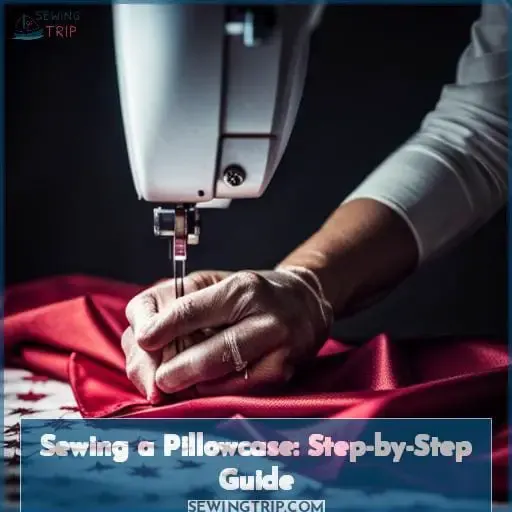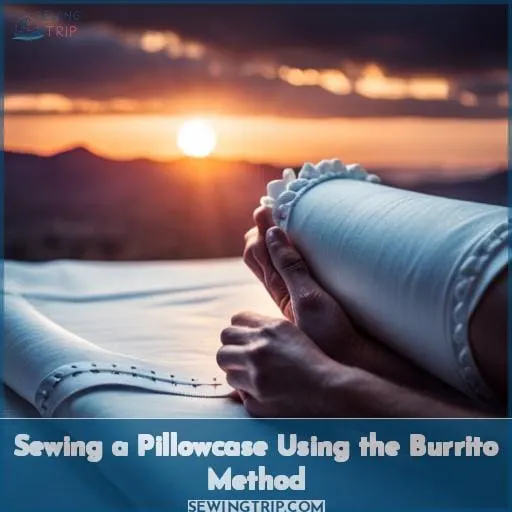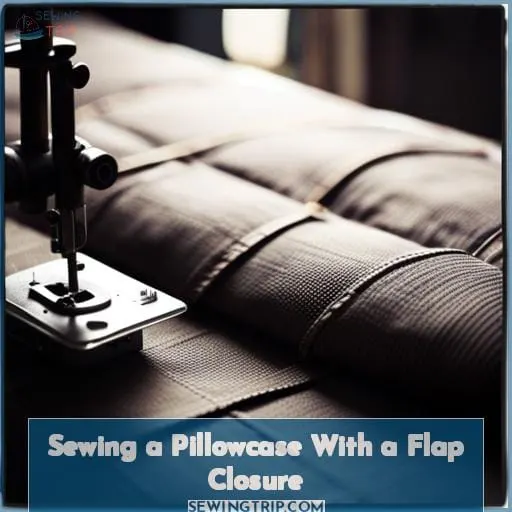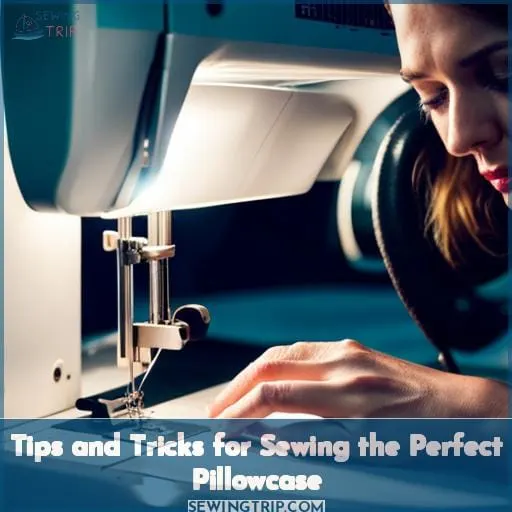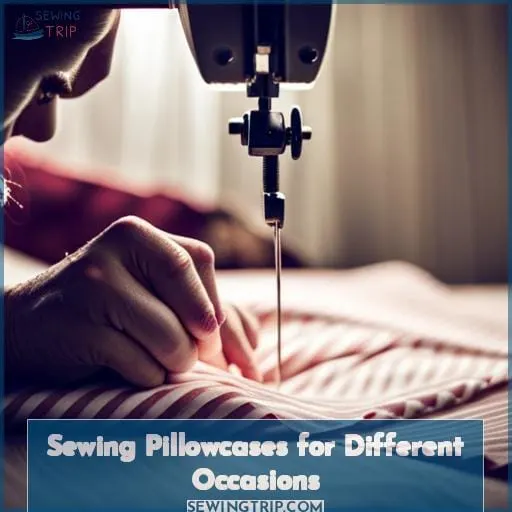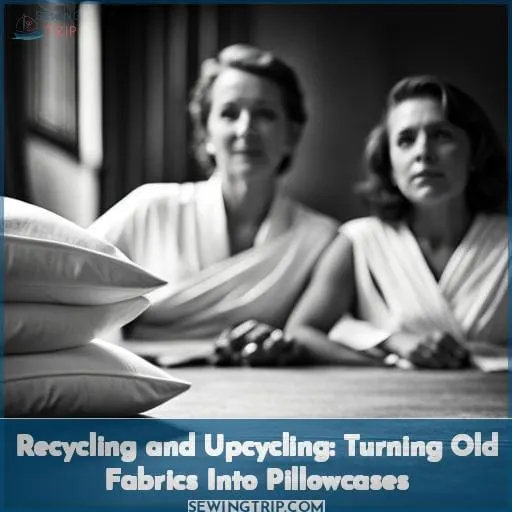This site is supported by our readers. We may earn a commission, at no cost to you, if you purchase through links.
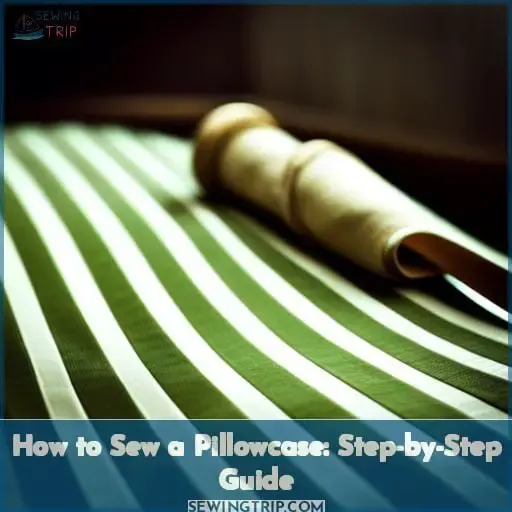 Discover the art of sewing and create a personalized touch to your bedroom decor with this step-by-step guide on how to sew a pillowcase.
Discover the art of sewing and create a personalized touch to your bedroom decor with this step-by-step guide on how to sew a pillowcase.
Unleash your creativity as you choose the perfect fabric, cut and press it with precision, and masterfully assemble each piece. With clear instructions and helpful tips along the way, you’ll be able to craft beautiful pillowcases that reflect your unique style in no time.
Get ready to elevate your sewing skills while adding comfort and charm to any space!
Table Of Contents
- Key Takeaways
- Sewing a Pillowcase: Step-by-Step Guide
- Understanding Pillow Sizes and Measurements
- Sewing a Pillowcase Using the Burrito Method
- Sewing a Pillowcase With a Flap Closure
- Adding Personalized Details to Your Pillowcase
- Tips and Tricks for Sewing the Perfect Pillowcase
- Sewing Pillowcases for Different Occasions
- Recycling and Upcycling: Turning Old Fabrics Into Pillowcases
- Frequently Asked Questions (FAQs)
- Conclusion
Key Takeaways
- Choose the right fabric: quilting cotton, linen, cotton sateen, or flannel.
- Cut the fabric pieces according to the desired size and align pattern motifs if using a print.
- Sew the front and back pieces together, exploring different embellishment ideas like appliqués or decorative stitches.
- Finish the pillowcase by turning and pressing it, and adding final touches such as sewing hems or attaching a label.
Sewing a Pillowcase: Step-by-Step Guide
Embark on the satisfying journey of crafting your own pillowcase with our comprehensive step-by-step guide.
Begin by carefully selecting the right fabric for your project, followed by precise cutting and pressing of fabric pieces.
Learn the art of layering and seamlessly stitching the front, culminating in the elegant finish of a French seam.
With clear instructions on hemming, assembly, and final touches, this guide ensures a rewarding and skill-enhancing experience in creating a personalized pillowcase tailored to your taste and bedroom aesthetics.
Choosing the Right Fabric
To sew a pillowcase, start by choosing the right fabric for your project.
Consider:
- Design
- Color coordination
- Texture options
- Print versatility
Cutting the Fabric Pieces
Once you’ve selected your fabric, gather your measurements and grab those scissors—you’re ready to cut the fabric pieces for your pillowcase.
Fabric Cutting Instructions
- Measure fabric according to desired size.
- Align pattern motifs if using a print.
- Consider French seams for neat edges.
Pattern Matching
- Align pattern motifs if using a print.
Seam Finishes
- Consider French seams for neat edges.
Pressing the Fabric
Now, press the fabric for smoothness:
- Gently glide the iron, avoiding excessive heat.
- Use steam for stubborn wrinkles.
- Maintain fabric integrity.
- Ensure wrinkle-free surfaces.
Layering the Fabric
After pressing the trim and border halves lengthwise, you’ll begin layering the front fabric pieces for your pillowcase.
| Fabric Layering | Seam Techniques |
|---|---|
| Design Variations | Fabric Embellishments |
Stitching Details:
- Envelope pillow cover pattern
- Pillow insert size
Sewing the Front of the Pillowcase
To sew the front of the pillowcase, secure and stitch together the layered fabric pieces using sewing techniques such as:
- Pinning or basting to hold layers in place
- Using a straight stitch with a suitable seam allowance
- Ensuring even stitching along edges for durability and aesthetics
- Exploring different embellishment ideas like appliques or decorative stitches.
Hemming the Back Piece
Next, you’ll hem the back piece of the pillowcase using a straight stitch and 1/2-inch seam allowance.
Press seams open, turn right side out, and press flat.
Assembling the Front and Back
Now, it’s time to bring the front and back pieces together by pinning and clipping them right sides together.
Stitch with a 1/2 inch seam allowance, trim the seam allowance, clip corners, and turn right side out.
Creating a French Seam
With the front and back of the pillowcase assembled, create a French seam to finish the raw edges.
Turning and Pressing the Pillowcase
After completing the French seam, turn and press the pillowcase to avoid wrinkles and bulk.
Use a point turner for precise corners.
Final Touches and Finishing
To complete your pillowcase, finish it off with some final touches and detailing such as:
- Turning right side out
- Pressing seams open
- Trimming excess fabric
- Sewing hems
- Attaching a label
Understanding Pillow Sizes and Measurements
When it comes to sewing a pillowcase, understanding the different sizes and measurements of pillows is crucial for achieving a proper fit.
Standard pillow size typically measures 20×26 inches (51cm x 56cm), while queen and king sizes are slightly larger at 20×30 inches (51cm x 76cm) and 20×36 inches (51 cm x92 cm) respectively.
It’s important to note that slight variations in measurements may exist, but the standard size remains widely used in bedding sets.
Standard Pillow Size
The standard pillow size is 20×26 inches (51cm x 56cm).
This is the size of a standard pillow insert.
Pillowcases are typically made to fit this size, but there’s slight variation in the actual dimensions.
Queen Pillow Size
Once you’ve chosen your fabric, you’ll need to know the queen pillow size to cut the correct dimensions.
- Length: 20 inches
- Width: 30 inches
Tuck in the corners and sew the pillowcase closed with a French seam.
King Pillow Size
A king pillow size is 20×36 inches.
| Pillow Size | Width | Length | Recommended Fabric | Tutorial | Closure |
|---|---|---|---|---|---|
| King | 20 inches | 36 inches | Quilting cotton | Burrito Method | Envelope |
Other Pillow Sizes and Dimensions
Sewing pillowcases in other sizes is just as easy as making a standard pillowcase.
- Euro sham size (26 x 26 inches)
- Travel pillow size (12 x 20 inches)
- Cushion size (16 x 16 inches)
- Pet bed size (24 x 30 inches)
- Toy car size (10 x 6 inches)
Sewing a Pillowcase Using the Burrito Method
To sew a pillowcase using the burrito method, you’ll first need to:
- Cut and prepare the fabric.
- Layer and sew the fabric.
- Create a folded cuff and sew the side seam.
- Finish the pillowcase by turning it right side out and pressing.
Step 1 – Cutting and Preparing the Fabric
To start, cut two pieces of fabric using the measurements provided in the previous section.
Press the fabric pieces with an iron before layering them together and pinning them in place.
Sew the pieces together using a sewing machine, then finish the pillowcase by turning it right side out and pressing it with an iron.
Step 2 – Layering and Sewing the Fabric
To layer and sew the fabric for your pillowcase using the burrito method, start by:
- Aligning and pinning the front pieces with the trim and border.
- Pin right sides together, ensuring raw edges are aligned.
- Sew with a 1/2-inch seam allowance.
- Press and pin as you go along.
Step 3 – Creating a Folded Cuff
Creating a folded cuff is an essential step in sewing a pillowcase using the burrito method.
Here’s how to do it:
- Fold the cuff lengthwise and press.
- Sew along the folded edge.
- Press the seam allowance towards the cuff.
- Pin and sew the cuff to one end of the pillowcase.
- Turn, press, and sew side seams.
Step 4 – Sewing the Side Seam
With the folded cuff in place, you can now sew the side seam of the pillowcase.
Pin or clip seam allowances together.
Align raw edges of fabric.
Sew a 1/2 inch seam allowance.
Press seam allowances open.
Trim seam allowances.
Step 5 – Finishing the Pillowcase
Turn the pillowcase right side out and press.
Clip the corners and topstitch the opening closed.
Hand sew the opening closed if you don’t have a sewing machine.
Sewing a Pillowcase With a Flap Closure
To sew a pillowcase with a flap closure, you’ll need to:
- Choose and cut the fabric
- Sew the flap
- Sew the side seams
- Finish the pillowcase
Step 1 – Choosing and Cutting the Fabric
To sew a pillowcase with a flap closure, you’ll need to choose and cut two pieces of fabric.
- Fabric weight should be light to medium-weight.
- Fabric grain should be straight.
- Fabric yardage should be 1-2 yards per pillowcase.
- Fabric store should have a variety of fabrics to choose from.
Step 2 – Sewing the Flap
Now, sew the flap of the pillowcase using a simple yet effective method.
First, align the right sides of the fabric pieces together and pin them in place.
Then, stitch along one side to secure them together.
Press open the seam allowance and fold it over to enclose raw edges.
Finally, stitch along all three sides for a neat finish.
| Steps | Instructions |
|---|---|
| 1 | Align right sides together |
| 2 | Pin in place |
| 3 | Stitch one side to secure pieces |
Step 3 – Sewing the Side Seams
Sew the side seams of your pillowcase with a flap closure, ensuring a secure and polished finish.
- Pin the sides together, aligning raw edges.
- Stitch along the pinned edge using a 1/2 inch seam allowance.
- Press open the seam allowances for a neat appearance.
- Trim any excess fabric to reduce bulkiness inside the pillowcase.
Step 4 – Finishing the Pillowcase
Step 4 – Finishing the Pillowcase
With the side seams sewn, you can now finish the pillowcase by attaching the flap.
Instructions:
- Pin the flap to the pillowcase, right sides together.
- Trim excess fabric.
- Fold the cuff over and press seams open.
- Turn the pillowcase right side out.
Adding Personalized Details to Your Pillowcase
You can personalize your pillowcases by:
- Adding embellishments and decorative stitches
- Appliques and patchwork designs
- Monograms and embroidery
- Fabric painting and stenciling
Embellishments and Decorative Stitches
To add a personal touch to your pillowcase, you can embellish it with hand-stitched details such as pintucks and pleats.
Enhance its beauty by adding lace and ribbon trims for a delicate touch.
For a more unique look, consider incorporating appliqué and patchwork designs or embroideries and monograms that reflect your style.
Let your creativity shine through these decorative stitches!
Appliques and Patchwork Designs
One way to personalize your pillowcase is by adding appliques and patchwork designs.
When choosing fabric for your design, consider the weight and quality of the material.
Placement and direction are important factors in achieving a visually appealing result.
Use stabilizer when applying appliqués to ensure they stay in place.
Consider quilting techniques and thread color options for patchwork designs that enhance the overall aesthetic of your pillowcase.
Monograms and Embroidery
Personalize your pillowcase with monograms and embroidery.
Add your initials or a special message to create a one-of-a-kind gift or home décor piece.
Learn about different types of monograms, embroidery stitches, and monogram fonts.
Choose between hand embroidery or machine embroidery, and use free monogram templates to create your own custom design.
Fabric Painting and Stenciling
With fabric painting and stenciling, you can add a unique and personal touch to your pillowcases.
Choose the right fabric for painting.
Select a stencil design that you like.
Apply fabric paint using a variety of techniques.
Heat set the paint according to the manufacturer’s instructions.
Tips and Tricks for Sewing the Perfect Pillowcase
To sew the perfect pillowcase,
- Use the right needle and thread
- Achieve straight seams and even stitching
- Press and iron for a professional finish
- Choose the right sewing machine settings
Using the Right Needle and Thread
To achieve straight seams and even stitching, pick the right needle and thread for your fabric.
The size of the needle should correspond to the weight of your fabric, with smaller numbers for lightweight fabrics and larger numbers for heavier fabrics.
Use a thread type that matches your fabric as well, such as cotton or polyester.
Additionally, ensure proper tension on your machine to prevent loose stitches or puckering in the finished pillowcase.
Achieving Straight Seams and Even Stitching
To ensure professional-looking results, it’s important to focus on achieving straight seams and even stitching when sewing a pillowcase.
- Use a walking foot.
- Test various tensions.
- Pin or baste seam allowances.
- Adjust the presser foot pressure.
- Use a seam guide.
Pressing and Ironing for a Professional Finish
Pressing and ironing are essential for achieving a professional finish on your pillowcases.
Use a steam iron on the cotton setting, and avoid scorching the fabric by ironing on a low heat setting.
| Step | What to do | Why |
|---|---|---|
| Press the fabric before cutting | To remove wrinkles and make it easier to sew | |
| Press the fabric after cutting | To create a smooth surface for sewing | |
| Press the seams open | To prevent puckering and make the pillowcase look neater | |
| Press the pillowcase flat | To ensure that it’s wrinkle-free |
Choosing the Right Sewing Machine Settings
Choosing the right sewing machine settings is essential for creating a professional-looking pillowcase.
The right stitch length, tension, needle size and type, thread type and weight, fabric type and weight, machine speed, and foot pressure will all contribute to a beautiful finished product.
Sewing Pillowcases for Different Occasions
You can sew pillowcases for different occasions, such as:
- Seasonal and holiday-themed pillowcases
- Baby and children’s pillowcases
- Travel and camping pillowcases
- Gifting pillowcases for special occasions
Seasonal and Holiday-Themed Pillowcases
For a festive touch, consider sewing seasonal and holiday-themed pillowcases to add charm and cheer to your bedroom décor.
Celebrate Christmas with cozy winter-themed pillowcases or decorate for Easter with colorful spring designs.
From Valentine’s Day hearts to Halloween motifs, there are endless possibilities for creating personalized pillowcases that capture the spirit of each occasion throughout the year.
Baby and Children’s Pillowcases
In addition to seasonal and holiday-themed pillowcases, you can also make baby and children’s pillowcases for special occasions.
Choose soft, machine-washable fabric and patterns that are safe for little ones.
Travel and Camping Pillowcases
Having kids means you’re always on the move, so making travel and camping pillowcases is a must.
These pillowcases should be:
- Waterproof
- Durable
- Compact
- Lightweight
- Breathable
Gifting Pillowcases for Special Occasions
Continuing on from gifting pillowcases to travelers, you can also gift pillowcases for special occasions. Pillowcases make thoughtful and personalized gifts that show gratitude and appreciation for others.
Recycling and Upcycling: Turning Old Fabrics Into Pillowcases
If you have old sheets or pillowcases that are no longer in use, you can upcycle them into new pillowcases! This is a great way to reuse old fabrics and give them a new life.
Repurposing Old Sheets and Pillowcases
Along with sewing pillowcases for different occasions, you can also repurpose old sheets and pillowcases into new ones. This is a great way to save money, cut waste, and practice zero-waste living. You can also use old fabrics to create unique and handmade pillowcases that are perfect for your home.
Using Vintage Fabrics for a Unique Look
You can give your old pillowcases a new life by turning them into one-of-a-kind pillowcases.
Look for vintage fabrics at:
- Antique stores
- Flea markets
- Online marketplaces
- Thrift stores
- Consignment shops
- Fabric salvage yards
- Surplus stores
- Local fabric stores
- Independent boutiques
Frequently Asked Questions (FAQs)
What is the best type of fabric to use for a pillowcase?
Quilting cotton is the best fabric to use for a pillowcase because it’s:
- Durable
- Breathable
- Wrinkle-resistant
How do I make sure my pillowcase fits my pillow perfectly?
You can make sure your pillowcase fits your pillow perfectly by measuring the pillow and adding 1 inch to each side.
What is the best way to sew a pillowcase with a flap closure?
To sew a pillowcase with a flap closure, start by:
- Cutting two pieces of fabric
- Sewing them together along three sides
- Leaving the fourth side open
- Folding it over to create a flap
- Stitching the flap in place
- Turning the pillowcase right side out.
How can I add personalized details to my pillowcase?
Personalize your pillowcases by adding:
- Embroidered initials
- Appliques
- Fabric paint designs
You can also sew contrasting piping or trim around the edges for a custom look.
What are some tips and tricks for sewing the perfect pillowcase?
To sew the perfect pillowcase, use quilting cotton fabric, a 1/2-inch seam allowance, and a French seam for neat edges.
Avoid making the case too small, and use pins to secure fabric layers before sewing.
Conclusion
With this pillowcase-making guide, you can easily sew your own custom pillowcases that are both stylish and functional.

